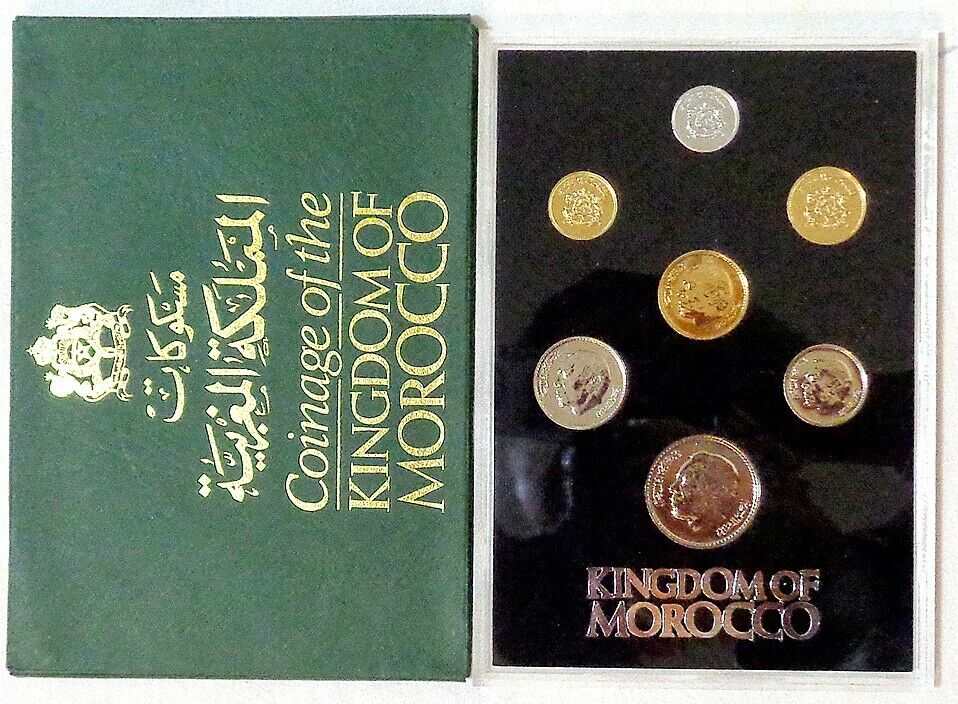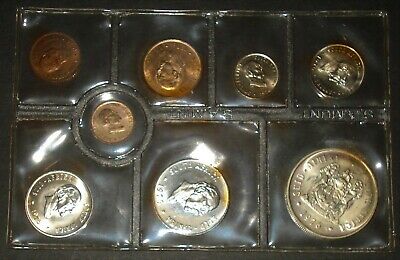-40%
Morocco 1974-75 Mint Set, 7 Coins KM# MS2, with Original Box
$ 31.67
- Description
- Size Guide
Description
Morocco 1974-75 Mint Set, 7 CoinsKM# MS2, with Original Box
Morocco, officially the Kingdom of Morocco, is the northwestern-most country in the Maghreb region of North Africa. It overlooks the Mediterranean Sea to the north and the Atlantic Ocean to the west, and has land borders with Algeria to the east, and the disputed territory of Western Sahara to the south. Morocco also claims the Spanish exclaves of Ceuta, Melilla and Peñón de Vélez de la Gomera, and several small Spanish-controlled islands off its coast. It spans an area of 446,550 km2 (172,410 sq mi) or 710,850 km2 (274,460 sq mi), with a population of roughly 37 million. Its official and predominant religion is Islam, and the official languages are Arabic and Berber; the Moroccan dialect of Arabic and French are also widely spoken. Moroccan identity and culture is a vibrant mix of Berber, Arab, and European cultures. Its capital is Rabat, while its largest city is Casablanca.
Inhabited since the Paleolithic Era over 90,000 years ago, the first Moroccan state was established by Idris I in 788. It was subsequently ruled by a series of independent dynasties, reaching its zenith as a regional power in the 11th and 12th centuries, under the Almoravid and Almohad dynasties, when it controlled most of the Iberian Peninsula and the Maghreb. In the 15th and 16th centuries, Morocco faced external threats to its sovereignty, with Portugal seizing some territory and the Ottoman Empire encroaching from the east. The Marinid and Saadi dynasties otherwise resisted foreign domination, and Morocco was the only North African nation to escape Ottoman dominion. The Alaouite dynasty, which rules the country to this day, seized power in 1631, and over the next two centuries expanded diplomatic and commercial relations with the Western world. Morocco's strategic location near the mouth of the Mediterranean drew renewed European interest; in 1912, France and Spain divided the country into respective protectorates, reserving an international zone in Tangier. Following intermittent riots and revolts against colonial rule, in 1956 Morocco regained its independence and reunified.
Since independence, Morocco has remained relatively stable and prosperous. It has the fifth-largest economy in Africa and wields significant influence in both Africa and the Arab world; it is considered a middle power in global affairs and holds membership in the Arab League, the Union for the Mediterranean, and the African Union. Morocco is a unitary semi-constitutional monarchy with an elected parliament. The executive branch is led by the King of Morocco and the prime minister, while legislative power is vested in the two chambers of parliament: the House of Representatives and the House of Councilors. Judicial power rests with the Constitutional Court, which may review the validity of laws, elections, and referenda. The king holds vast executive and legislative powers, especially over the military, foreign policy and religious affairs; he can issue decrees called dahirs, which have the force of law, and can also dissolve the parliament after consulting the prime minister and the president of the constitutional court.
These coins were made at the Royal Mint, Llantrisant, United Kingdom. There are seven coins in this set, and it is designated KM# MS2. 13,743 of these sets were made. All of the coins are round, and all of the coins have small dots all around the border on both the obverse and reverse sides. The 1 and 5- Santimat coins have smooth edges. The other five coins have ribbed (or milled) edges. The coins are sealed in a plastic case. The original box is included. Although this coin set is listed as a mint set in Krause, the coins all have high relief and mirror finishes. They appear to be more like proof coins than BU coins.
This table provides significant facts about the coins:
Coin
Yoeman No.
Composition
Fineness
Weight
Diameter
Finish
Obverse/Reverse
1 Santim
58
Aluminum
N/A
0.70 grams
17mm
Proof
Crowned Arms/Value
5 Santimat
59
Aluminum-Bronze
N/A
2.00 grams
17.5mm
Proof
Crowned Arms/Captain's Wheel
10 Santimat
60
Aluminum-Bronze
N/A
3.00 grams
20mm
Proof
Crowned Arms/Sunflowers
20 Santimat
61
Aluminum-Bronze
N/A
4.00 grams
23mm
Proof
King al Hassan II/Crowned Arms
50 Santimat
62
Copper-Nickel
N/A
4.00 grams
21mm
Proof
King al Hassan II/Crowned Arms
1 Dirham
63
Copper-Nickel
N/A
6 grams
24mm
Proof
King al Hassan II/Crowned Arms
5 Dirhams
64
Copper-Nickel
N/A
12 grams
29mm
Proof
King al Hassan II/World Food Designs
The obverse side of the coins has the crowned coat of arms on the 1, 5 and 10-santimat coins; and a bust of King al Hassan II (facing left) on the other four coins. Around the top, and near the border, of the three coins with the coat of arms, is Arabic lettering that translates to "Moroccan Kingdom". The four coins with the al Hassan II bust have "Kingdom of Morocco" by the upper left border, and "Hassan II" by the lower right border.
The reverse side of the 1-santim coin has a large numeral 1 in the center, with arrow designs to the left and right sides of it. The 5-santimat coin has a ship's wheel (captain's wheel for steering) and a fish in a net. The 10-santimat coin has sunflowers. The 20 and 50-santimat and 1-dirham coins have the coat of arms; and the 5-dirhams coin has a sugar beet and a dam. All of the coins have the Christian and Arabic dates on them. They also have a numeral for the denomination, and the denomination word (santimat or dirham) written in Arabic.
These are essentially proof-quality coins. Please see the photos. The silver color of the coins may show as black in the scanned images. The photo images may provide an indication of the actual color. Because all the images were taken through the plastic, any dirt or distortion is due to the plastic and is not on the coins. The coins have never been removed from the plastic case.
















